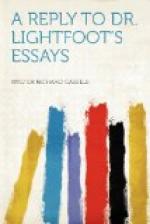Griesbach and Kestner both express “doubts
more or less definite,”
but to make sufficient extracts
to illustrate this would occupy
too much space.
Neander.—Dr. Lightfoot has been
misled by the short extract from
the English translation of
the first edition of Neander’s History
given by Cureton in his Appendix,
has not attended to the brief
German quotation from the
second edition, and has not examined the
original at all, or he would
have seen that, so far from pronouncing
“in favour of a genuine
nucleus,” Neander might well have been
classed by me amongst those
who distinctly reject the Ignatian
Epistles, instead of being
moderately quoted amongst those who
merely express doubt.
Neander says: “As the account of the martyrdom
of Ignatius is very suspicious,
so also the Epistles which suppose
the correctness of this suspicious
legend do not bear throughout the
impress of a distinct individuality,
and of a man of that time who
is addressing his last words
to the communities. A hierarchical
purpose is not to be mistaken.”
In an earlier part of the work he
still more emphatically says
that, “in the so-called Ignatian
Epistles,” he recognises
a decided “design” (Absichtlichkeit),
and
then he continues: “As
the tradition regarding the journey of
Ignatius to Rome, there to
be cast to the wild beasts, seems to me
for the above-mentioned reasons
very suspicious, his Epistles, which
presuppose the truth of this
tradition, can no longer inspire me
with faith in their authenticity.”
[72:1] He goes on to state
additional grounds for disbelief.
Baumgarten-Crusius stated in one place, in
regard to the seven
Epistles, that it is no longer
possible to ascertain how much of the
extant may have formed part
of the original Epistles, and in a note
he excepts only the passages
quoted by the Fathers. He seems to
agree with Semler and others
that the two Recensions are probably
the result of manipulations
of the original, the shorter form being
more in ecclesiastical, the
longer in dogmatic, interest. Some years
later he remarked that enquiries
into the Epistles, although not yet
concluded, had rather tended
towards the earlier view that the
Shorter Recension was more
original than the Long, but that even the
shorter may have suffered,
if not from manipulations
(Ueberarbeitungen),
from interpolations. This very cautious
statement, it will be observed,
is wholly relative, and does not in
the least modify the previous
conclusion that the original material
of the letters cannot be ascertained.
Dr. Lightfoot’s objections regarding these seven writers are thoroughly unfounded, and in most cases glaringly erroneous.




